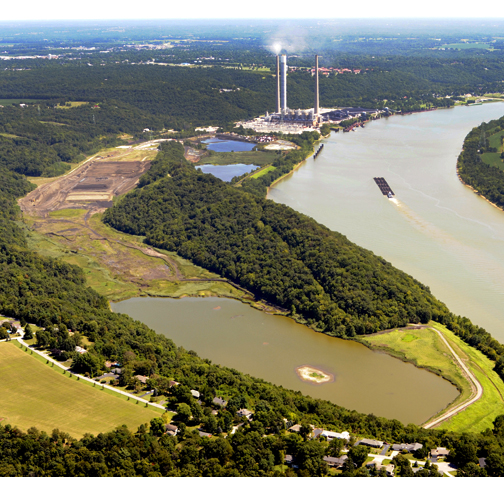March 2, 2011-by Lisa Evans in the EarthJustice blog.
If you live in Indiana, it’s best not to live below one of the state’s 53 coal ash dams.

Coal waste ponds like these at the Clifty Creek power plant in Madison, IN leave drinking water systems like the Ohio River (at right) vulnerable, especially if regulation of them is lax. Indiana has lax regulation. In fact, Indiana allowed the coal ash landfill to the left to place a liner (which was a positive development on top of the very coal ash the liner was to protect from groundwater. Bizarre to say the least. File Photo © 2010 John Blair
The state’s laissez-fare attitude toward these deadly structures has created a potentially disastrous public hazard. Recent dam breaks in Indianapolis should have sounded the alarm, but apparently it takes more than 30 million gallons of toxic waste to get the state’s attention. Even a failing report card last month from EPA inspectors hardly raised an eyebrow. The colossal collapse in 2008 of TVA’s high hazard dam in Harriman, Tennessee is apparently a distant memory in the Hoosier State.
But forgetting this lesson may place thousands in harm’s way.
Last spring, the EPA conducted 69 inspections of coal ash surface impoundments (ponds) at 20 power plants across the country, including ponds at six Indiana plants. The EPA inspectors gave a “poor” rating to 35 ponds– more than half of the ponds inspected Most notable was that 24 of the “poor” rated ponds (two-thirds of the total) were found at just four Indiana power plants. These 24 ponds include 6 high hazard dams, 15 significant hazard dams and 3 low hazard dams.
According to the EPA, high hazard dams are those “where failure or mis-operation will probably cause loss of human life.” Significant hazard dams are those dams where failure or mis-operation results will cause economic loss, environment damage, disruption of lifeline facilities, or impact other concerns.
The Indiana waste ponds rated “poor” together hold more than 3 billion gallons of toxic waste and cover an area greater than 600 football fields- or an area about two-and-a-half times the Indianapolis Motor Speedway. This extraordinarily number of poor-rated toxic ponds in Indiana is caused by operator neglect as well as the grossly deficient state regulatory program. Despite the fact that Indiana is home to the largest collection of coal ash ponds in the United States, Indiana regulators fail to require even the most basic safeguards. Witness:
- Dam design by a professional engineer is not required (only two other states fail to require design by a professional engineer)
- Indiana utilities are not required to inspect their own dams. The state inspects coal ash dams infrequently, if at all
- Indiana utilities are not required to report to the state on dam condition or operation
- Indiana utilities need not maintain an emergency response plan in the event of dam failure
- Indiana utilities are not required to create an inundation map (a map of the area that would be covered in toxic waste in the event of a break)
- Indiana regulations do not require the power plants to post bonds (financial assurance to cover damage in the event of the failure).
Indiana is the third-largest coal ash generating state in the U.S., and its primary disposal method is to dump the waste in unlined and poorly regulated coal ash waste ponds. Most of the dams rated “poor” will likely take human life or cause substantial economic and environmental damage if they fail.
It is the responsibility of the utility operating the ponds to ensure a break never occurs. But when polluters fail to protect public safety, it is the responsibility of the regulators to step in. It appears that all have failed the citizens of Indiana. (Go to Original)

